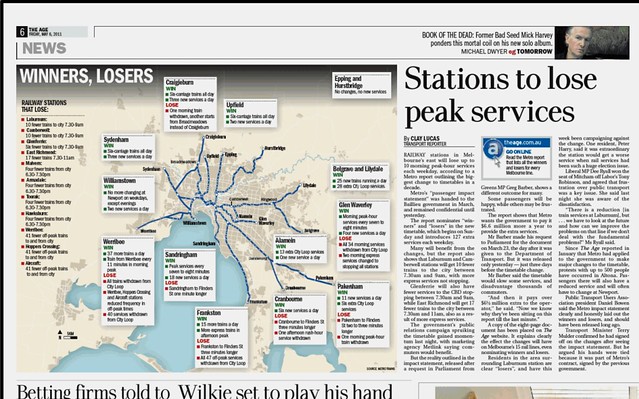Probably just as well for this onsert:
…that this story landed on page 6, not on page 1:
The full story text is here: Stations to lose peak services. And here’s a big version of the map.
The document the article talks about is here: Passenger Impact Statement.
To decode it, you’ll need to look at the station code list. “AMP” is AM peak, “PMP” PM peak, “AOP” AM off-peak, “POP” PM off-peak. “a/c” is railways code for “because of”.
- See also: PTUA’s PT Problem of the Day: Train timetables getting more, or less complicated? (and Laburnum loses out)
- My post back in March about the changes
PS. I noticed that in fact there’s a Metro advert on pages 6-7, below the story. Not ideal placement.


6 replies on “Lucky this Age story didn’t make page 1”
The new timetable has moved my friend permanently from public transport to her car. She works in Camberwell and used to get the train from Bayswater, but now will be unable to do that without either changing trains or travelling earlier. She would need to leave home 35 minutes earlier to use the train than to use her car.
It’s rather odd that such a populated and busy suburb as Camberwell is to have fewer train services with this new timetable. I would have thought it was a major station at which all trains should stop.
I guess encouraging non-CBD workers to use their cars is one way to reduce demand on the trains.
I would have thought not stopping at Camberwell will certainly speed up the express services. Looking at Laburnum, I note in two instances that an express train arrives two minutes after a stopping train. What does human nature dictate? Catch the stopping train in case the express is late or cancelled, or with some faith, wait for the express? I guess that is where those annoying information buttons that people push constantly come into their own.
So far I’ve only had a cursory glance at the timetables’ actual design (as opposed to the total number of services per hour), but from what I’ve seen, the explanations are thus:-
1. Expressing Laburnam:
This is the result of a) a station with less than 3,500 people per day being overserviced; comparable stations by patronage have around half the number of trains per hour in peak currently, and in the new timetable. And b), it’s necessary in order to squeeze as many trains through the section as possible. Take a look at the trains’ times at Blackburn and Box Hill, and you’ll see that generally speaking, the trains are within 2-3 minutes of each other. It’s ok to depart an express 2min before a stopping train because the difference in speeds will compensate for the closeness, but in practice it’s preferable to have at least three minutes between trains on that section in order to maintain reliability.
2. Camberwell:
Apparently the theory here is that the express trains which used to stop at Camberwell were too full for people to get on, and there weren’t enough people making trips to Camberwell to make it worth stopping there.
Then clearly, more trains are needed for all the people trying to get on at Camberwell. Now there will be fewer. Sounds like an abandonment of Camberwell because extra capacity is unavailable.
There is plenty of AM peak capacity at Camberwell – on the stoppers.
However while the expresses go the loop, and the stoppers (typically Blackburn, Alamein trains) to FSS, I don’t see the capacity issues changing with current passenger preferences (25% FSS, 75% loop). Admittedly passenger preferences might change if FSS becomes the more common destination.
The current arrangements appear to favour the longer distance travellers at the expense of those living in the supposedly easier/better service inner suburbs.
@Dave – in the new timetable, all trains that run through Hawthorn before midday run through the Loop, while the Glen Waverley trains will run direct.
@Phillip – it seems the only way to force Camberwell passengers on to stopping-all-stations trains is to withdraw the (full) express services completely. That’s just the way it works out.